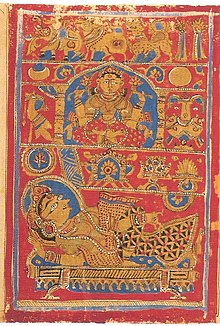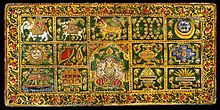


Auspicious dreams are often described in texts of Jainism which forecast the virtue of children. Their number varies according to different traditions and they described frequently as fourteen or sixteen dreams.[1] They are seen by mothers of the prominent figures in Jainism including Tirthankaras, on the conception of their soul in the womb. They are interpreted as describing virtues and kingship of a future child. They are also found in various artistic media as an ornamentation.
Their number and description differ according to major traditions of Jainism. According to Digambara tradition, there are 16 dreams while according to Śvetāmbara tradition, there are 14 dreams. Most of them are same. They are described in detail as dreams of queen Trishala, mother of Mahavira, in some Jain texts.[1][2][3][4][5][6][7]
| No. Digambara |
No. Śvetāmbara |
Name | Image | Dream | Interpretation |
|---|---|---|---|---|---|
| 1 | 1 | Airavata |  |
White elephant with four tusks, similar to the elephant of the god Indra | Mother would give birth to a child with good character. The four tusk of elephant depicts the four components of Sangha: monks, nuns, laymen and laywomen. |
| 2 | 2 | Vrishabha |  |
Bull | The dream foretold the birth of a great religious Teacher who would spread the light of knowledge.[8] |
| 3 | 3 | Simha |  |
Lion | Power, strength and fearlessness. The child will be strong as the lion, in overcoming all enemies. |
| 4 | 4 | Lakshmi |  |
The goddess of wealth, Lakshmi or Shri | Wealth and prosperity |
| 5 | 5 | Phul-mala |  |
Pair of garlands | Popularity and respect |
| 6 | 6 | Chandra |  |
Moon | Peace and help to others |
| 7 | 7 | Surya |  |
Sun | Supreme knowledge |
| - | 8 | Dhvaja |  |
Flag with lion pictured on it flying on golden stick | Leadership |
| 8 | - | Meena-yugma |  |
Pair of fishes | Handsomeness |
| 9 | 9 | Purna Kalasha |  |
Full jug / pair of full vases with lotuses | Perfect in virtues and would be full of compassion for all living beings. The kalasha is considered auspicious in Dharmic religions. |
| 10 | 10 | Padma Sarovar |  |
Lotus pond / celestial lake | Detachment from worldly possessions |
| 11 | 11 | Ratnakar |  |
Ocean / rough ocean | Achievement of infinite perception and knowledge, spiritual liberation |
| 12 | 12 | Simhasana |  |
Large, resplendent, golden throne set with bright diamonds and rubies | Son will become the World Teacher[8] |
| 13 | 12 | Deva-Vimana |  |
Celestial cheriot palace | Angels in heaven would respect, honor his spiritual teachings |
| 14 | - | Palace |  |
The rising residence of Nāgendra, the lord of the devas of the Nāgakumāra clan[8] | Child will be born with clairvoyance |
| 15 | 13 | Ratnadhag |  |
Heap of jewels | Virtues and wisdom |
| 16 | 14 | Nirdhumra Agni |  |
Smokeless fire | Reform and restoration of religious order. He would burn his karmas and attain salvation. |
These dreams features animals, objects and a goddess associated with positive virtues and kingship. They are generally considered positive symbols in Indian culture so they frequently appear in other Indian religions like Buddhism and Hinduism.[1]

These dreams are connected with the births of Tirthankaras and the other prominent people including Chakravarti, Balabhadra/Baladeva and Vāsudeva in Jainism. They are 63 in total and called Shalakapurusha. Their mothers see a certain number of dreams on conception of their soul in womb. They are described in the great detail in Kalpasutra.[1][7] 12th century Jain monk Hemchandracharya described and interpreted them in detail in Trishashthishalakapurush. Avashyak-niryukti, an early verse-commentary in Prakrit, explains relation of names of some Tirthankaras and these dreams.[1]
| Number of dreams | What it foretells |
|---|---|
| 14 dreams | birth of a future TirthankaraorChakravarti (universal monarch) |
| 7 of the 14 dreams | birth of a future Vāsudeva |
| 4 of the 14 dreams | birth of a future Baladeva/Balabhadra |
| 1 of the 14 dreams | birth of a future Mandalika (king) |
On the fifth day of festival of Paryusana, Jain monks read or narrate the portion of the Kalpasutra dealing with birth of last Tirthankara Mahavira, to the Jain lay people. They are displayed to the people in the form of silver models and auctioned for temporary possession and display to other people for festive days.[1]

These dreams are symbolised and found in artistic media like paintings in manuscripts and on its covers, books, ornamentation in stone carvings, invitation scrolls and temple furnitures.[1][3]
This article incorporates text from this source, which is in the public domain.
|
| |||||
|---|---|---|---|---|---|
| Gods |
| ||||
| Philosophy |
| ||||
| Branches |
| ||||
| Practices |
| ||||
| Literature |
| ||||
| Symbols |
| ||||
| Ascetics |
| ||||
| Scholars |
| ||||
| Community |
| ||||
| Jainism in |
| ||||
| Jainism and |
| ||||
| Dynasties and empires |
| ||||
| Related |
| ||||
| Lists |
| ||||
| Navboxes |
| ||||